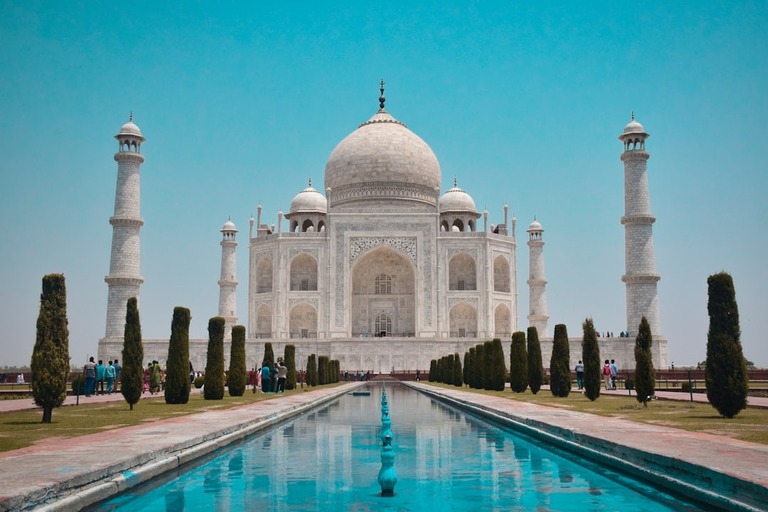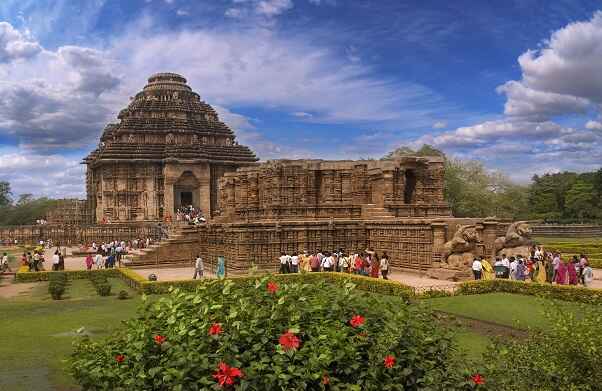
Imagine gazing up at a towering marble dome, its white surface glowing pink in the early morning light. Or picture yourself walking through a massive sandstone gateway, the echoes of Mughal emperors and mighty dynasties still lingering in the air. The monuments of India are more than just architectural wonders – they are living testaments to the country’s rich history and cultural heritage.
In 2025, these iconic landmarks continue to captivate travellers from around the world. Whether you’re a history buff eager to uncover the secrets of ancient empires or a curious explorer looking to immerse yourself in India’s vibrant culture, the country’s famous monuments offer a portal to the past that is both educational and awe-inspiring.
But with so many incredible heritage monuments to choose from, it can be tough to know where to start.
That’s why we’ve put together this definitive guide to the top 10 monuments of India that you absolutely must visit. From the Taj Mahal to the Ajanta Caves, we’ll take you on a journey through India’s most important historical sites, revealing the fascinating stories and cultural significance behind each one.
So, if you’re ready to step back in time and discover the true essence of India, read on for our insider’s guide to the country’s most iconic monuments. Your adventure awaits!
1. Taj Mahal, Agra – A Monument to Eternal Love

Picture yourself strolling along a serene reflecting pool, the Taj Mahal‘s pristine white marble dome rising majestically ahead, its symmetry a breathtaking sight as morning mist swirls around its minarets. This UNESCO World Heritage Site, often hailed as the national monument of India, is undeniably the most famous monument of India. Commissioned by Emperor Shah Jahan between 1632 and 1653 to honour his beloved wife Mumtaz Mahal, who died during childbirth, it’s a poignant symbol of eternal love crafted by over 20,000 artisans.
Marvel at the intricate pietra dura inlays—delicate floral patterns in jasper, jade, and lapis lazuli—adorning its walls, and the calligraphic verses framing its arches. Visit at sunrise for a golden glow or opt for a rare full-moon night tour when it shimmers under lunar light. Bring your family to picnic in its Mughal gardens or capture its beauty with friends—it’s a cornerstone of historical monuments of India that speaks to the heart.
Step Into History with Our Agra Tour Packages
2. Red Fort, Delhi – The Mughal Powerhouse

Imagine passing through the towering Lahori Gate, its red sandstone walls glowing in the afternoon sun, as you step into the sprawling complex of the Red Fort. Built by Shah Jahan in 1648 as the centrepiece of his new capital, Shahjahanabad, this UNESCO-listed fortress ranks among the important monuments of India for its role in Mughal governance.
You can explore the Diwan-i-Aam, where the emperor once heard public grievances, or the opulent Diwan-i-Khas, its marble pillars inscribed with Persian poetry praising its grandeur. The fort’s historical significance peaks annually on 15 August, when India’s Prime Minister hoists the national flag—a proud moment for this national monument of India. In 2025, wander its museums filled with Mughal artefacts or linger for the evening sound-and-light show narrating its saga—it’s a must-see among monuments of India for history enthusiasts and urban adventurers.
Discover the Heart of India – Book Your Delhi Tour Package Now
3. Qutub Minar, Delhi – The Towering Triumph

Ever fancied gazing up at a 73-metre minaret, its red sandstone and marble tiers climbing skyward, each carved with intricate patterns that whisper of a bygone era? Qutub Minar, a UNESCO treasure, stands tall among historical monuments of India. Qutb-ud-din Aibak, the first Delhi Sultan, began building it in 1192 and was completed by his successors over centuries.
You can trace its five distinct storeys, adorned with Persian calligraphy and delicate balconies, a testament to the Delhi Sultanate’s architectural prowess and military victories. Nearby, the 4th-century Iron Pillar, mysteriously rust-free, adds an enigma to your visit. You can snap photos against its towering silhouette or enjoy a quiet picnic with family in its lush complex—one of India’s famous monuments blending history with awe-inspiring beauty.
4. Gateway of India, Mumbai – The Colonial Welcome

Picture yourself on Mumbai’s bustling waterfront, the Gateway of India’s grand basalt arch rising before you, framing the endless Arabian Sea as ferries bob in the rain-soaked breeze. Erected in 1924 to mark King George V and Queen Mary’s 1911 visit, this heritage monument of India fuses Indo-Saracenic arches with European flourishes, a nod to colonial pomp.
You’ll feel the pulse of the city—tourists snapping selfies, vendors hawking chai, and boats departing for Elephanta Caves. Its historical significance deepened in 1948 when the last British troops marched out, symbolising independence. In 2025, take a monsoon boat ride or sip tea at a nearby café—it’s a living landmark among monuments of India, perfect for jetsetters and families craving urban heritage.
5. Hawa Mahal, Jaipur – The Palace of Winds

Fancy standing behind 953 latticed windows, the breeze flowing through as you peek at Jaipur’s vibrant streets below, just as royal women once did? Hawa Mahal, built in 1799 by Maharaja Sawai Pratap Singh, is a pink sandstone marvel among famous monuments of India; its honeycomb facade is a masterpiece of Rajput and Mughal design.
Climb its five storeys, each jharokha—small window—cooling the interior naturally, earning its “Palace of Winds” moniker. Its historical significance lies in offering seclusion for the royal zenana while connecting them to the world outside. Visit at sunrise when its rosy hue glows, or pair it with a City Palace tour with friends—it’s a heritage monument of India that enchants with its delicate beauty.
6. India Gate, Delhi – The War Memorial Majesty

Imagine strolling beneath a 42-metre arch, its honeyed stone aglow at dusk, the eternal flame of Amar Jawan Jyoti flickering in tribute to fallen heroes. India Gate, unveiled in 1931 by Sir Edwin Lutyens, is a national monument of India honouring 70,000 British Indian soldiers lost in World War I and the Third Anglo-Afghan War. You can read names etched into its walls, a sombre roll call of sacrifice, or join locals picnicking on its sprawling lawns—a Delhi tradition. Added in 1945, the flame deepens its reverence as a symbol of modern India’s resilience. In 2025, visit as evening lights bathe it in gold—it’s one of the important monuments of India for a reflective pause with family or mates.
7. Mysore Palace, Karnataka – The Regal Splendour

Have you ever dreamt of stepping into a palace straight from a fairy tale, its golden domes and arches shimmering under a canopy of festive lights? Mysore Palace, rebuilt in 1912 after a fire razed its wooden predecessor, is a heritage monument of India showcasing Indo-Saracenic splendour under the Wodeyar dynasty.
You can wander the Durbar Hall, its stained-glass ceilings casting kaleidoscopic patterns, or gape at the jewel-encrusted golden throne unveiled during Dasara. Its historical significance spans centuries of royal rule, blending Hindu and Islamic styles. You can catch the Sunday night illumination—10,000 bulbs dazzling—or explore its artefact-filled museums—it’s a regal gem among famous monuments of India for families and culture seekers.
8. Ajanta & Ellora Caves, Maharashtra – The Rock-Cut Wonders

Picture yourself in dimly lit caves, ancient Buddhist murals glowing on damp stone walls, their colours vivid despite millennia. The Ajanta and Ellora Caves, UNESCO treasures, are historical monuments of India carved between the 2nd century BCE and 6th century CE.
At Ajanta, you can explore the 30 Buddhist caves, their Jataka tale paintings depicting the Buddha’s life. In comparison, Ellora’s 34 caves blend Buddhist, Hindu, and Jain artistry. Their significance lies in showcasing India’s religious harmony and artistic zenith. You can trek with a guide or soak in their meditative calm—they’re among the monuments of India for jetsetters and history lovers craving ancient marvels.
9. Charminar, Hyderabad – The Four-Pillared Legacy
Imagine ascending a spiral staircase to a minaret’s balcony, Hyderabad’s skyline sprawling beneath you as the muezzin’s call echoes through the rain. Charminar, built in 1591 by Muhammad Quli Qutb Shah to mark Hyderabad’s founding and a plague’s end, is an important monument of India with its four 56-metre arches blending Persian and Indian aesthetics.
Explore its bustling base, shop for pearls at Laad Bazaar, or sip Irani chai nearby. Its historical significance anchors Hyderabad’s Qutb Shahi legacy. Visit at night when its lights dance—it’s a heritage monument of India that thrills families and friends with its vibrant chaos.
10. Konark Sun Temple, Odisha – The Solar Chariot

Fancy standing before a colossal stone chariot, its 24 wheels carved with celestial precision, rolling eternally toward the sun? The Konark Sun Temple, a 13th-century UNESCO site, is one of the famous monuments of India, built by King Narasimhadeva I to honour Surya, the Sun God.
You can trace its sundial wheels and intricate erotic sculptures, reflections of Kalinga artistry and Odisha’s maritime past. Its historical significance is tied to a golden era of trade and devotion. Pair it with a Puri beach trip or explore its ruins at sunset—it’s a historical monument of India that mesmerises adventurers and culture enthusiasts.
Why These Monuments Matter
India’s monuments of India are more than stone and mortar—they’re the heartbeat of a nation’s past, weaving a tapestry of empires, faiths, and human spirit. The Taj Mahal’s romantic legacy, Red Fort’s Mughal might, and India Gate’s solemn tribute span centuries, each a UNESCO jewel or national monument of India drawing millions. You’ll see Mughal marble mastery, Rajput ingenuity, and rock-cut devotion, showcasing architectural brilliance that defines the heritage monuments of India.
They invite you to connect with history—whether tracing dynasties at Qutub Minar or marvelling at Mysore’s opulence. These important monuments of India are living legacies, making them unmissable for any traveller.
Tips for Visiting India’s Iconic Monuments
Ready to explore the top 10 famous monuments of India? Here’s how to make your trip seamless:
- Timing is Everything: Catch Taj Mahal at dawn, Red Fort’s evening show—light transforms their magic.
- Dress Smart: Lightweight attire and comfy shoes suit Agra’s humidity or Ellora’s rocky paths.
- Guides Unlock Secrets: Hire locals at Charminar or Ajanta for tales cameras can’t capture.
- Respect Rules: Photography’s welcome, but drones need permits at sites like India Gate.
- Seasonal Planning: Monsoon (June-September) adds drama to Gateway of India; winter (October-March) suits Konark’s coastal charm.
These tips ensure your journey to the historical monuments of India is as enriching as their legacies.
Conclusion
India’s top 10 iconic monuments, from the Taj Mahal’s marble poetry to Konark’s solar chariot, are more than just famous monuments of India—they’re gateways to a storied past. These historical monuments of India beckon families, friends, and jetsetters with their timeless allure, each a heritage monument of India pulsing with history.
Whether it’s the Red Fort’s grandeur or Hawa Mahal’s delicate charm, every national monument of India tells a unique tale. SOTC offers tailored packages—guided tours, comfy stays, and cultural immersions—to bring these monuments of India to life. Book now and step into India’s epic saga!





Related Post
10 Reasons Why You Should Book a Luxury Villa for your Next Stay
Top Places For Monsoon Treks in Maharashtra
Know Why You Should Visit Lonavala in Monsoon
Explore the List of Top Lonavala Waterfalls That You Must Visit This Monsoon
The Best Places to Visit in July to Embrace the Beauty of Monsoon in India
Monsoon Magic: The Best Places to Visit in September in India
Amarnath Yatra : The Best Time to Visit and Must-See Places
Amarnath Yatra 2025 - Route, Dates and All You Need to Know
How Much Does a Goa Trip Cost?
Explore the 10 Gems of Andhra Pradesh